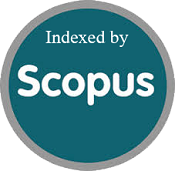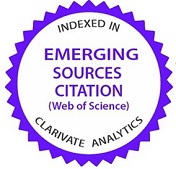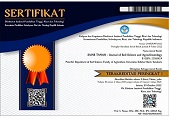Peat soil treatment using hydrogen peroxide and its adsorption towards potassium ion (K+) in aqueous solution
Abstract
Keywords
Full Text:
PDFReferences
Anda, M., Ritung, S., Suryani, E., Sukarman, Hikmat, M., Yatno, E., . . . Husnain. (2021). Revisiting tropical peatlands in Indonesia: Semi-detailed mapping, extent and depth distribution assessment. Geoderma, 402, 115235. https://doi.org/10.1016/j.geoderma.2021.115235
Ansone-Bertina, L., & Klavins, M. (2016). Sorption of V and VI group metalloids (As, Sb, Te) on modified peat sorbents. Open Chemistry, 14(1), 46-59. https://doi.org/10.1515/chem-2016-0003
Awgchew, H., Beyene, S., & Kifilu, A. (2024). Potassium adsorption capacity and desorption kinetics in soils of Qenberenaweti sub-watershed, central highlands of Ethiopia. Heliyon, 10(10), e31336. https://doi.org/10.1016/j.heliyon.2024.e31336
Azmi, I. A., & Kassim, N. Q. B. (2022). Changes in soil microstructure and physical characteristics of peat soils under pineapple plantation. IOP Conference Series: Earth and Environmental Science, 1059(1), 012027. https://doi.org/10.1088/1755-1315/1059/1/012027
Bangroo, S., Mushtaq, A., Tahir, A., Malik, M., Kirmani, N., Sofi, J., & Rasool, F.-u. (2012). Potassium adsorption characteristics of soils under long term maize-legume cropping sequence. African Journal of Agricultural Research, 7(48), 6502-6507. https://doi.org/10.5897/AJAR12.1751
Binner, I., Dultz, S., Schellhorn, M., & Schenk, M. K. (2017). Potassium adsorption and release properties of clays in peat-based horticultural substrates for increasing the cultivation safety of plants. Applied Clay Science, 145, 28-36. https://doi.org/10.1016/j.clay.2017.05.013
Burek, B. O., Bormann, S., Hollmann, F., Bloh, J. Z., & Holtmann, D. (2019). Hydrogen peroxide driven biocatalysis [10.1039/C9GC00633H]. Green Chemistry, 21(12), 3232-3249. https://doi.org/10.1039/C9GC00633H
Bustin, R. M., & Lowe, L. E. (1987). Sulphur, low temperature ash and minor elements in humid–temperate peat of the Fraser River Delta, British Columbia. Journal of the Geological Society, 144(3), 435-450. https://doi.org/10.1144/gsjgs.144.3.0435
Caramalău, C., Bulgariu, L., & Macoveanu, M. (2009). Cobalt (II) removal from aqueous solutions by adsorption on modified peat moss. Chemical Bulletin of “Politehnica” University of Timisoara, 54(68), 13-17. https://www.researchgate.net/publication/237483319_Cobalt_II_Removal_from_Aqueous_Solutions_by_Adsorption_on_Modified_Peat_Moss
Carrillo Zenteno, M. D., de Freitas, R. C. A., Fernandes, R. B. A., Fontes, M. P. F., & Jordão, C. P. (2013). Sorption of Cadmium in Some Soil Amendments for In Situ Recovery of Contaminated Soils. Water, Air, & Soil Pollution, 224(2), 1418. https://doi.org/10.1007/s11270-012-1418-8
Cocozza, C., D'Orazio, V., Miano, T. M., & Shotyk, W. (2003). Characterization of solid and aqueous phases of a peat bog profile using molecular fluorescence spectroscopy, ESR and FT-IR, and comparison with physical properties. Organic Geochemistry, 34(1), 49-60. https://doi.org/10.1016/S0146-6380(02)00208-5
Detho, A., Rosli, M. A., Ghazouani, N., Mabrouk, A., Elhag, A. B., Kadir, A. A., . . . Rassem, H. H. (2025). Potential of composite adsorbent comprising peat, limestone, zeolite, and activated carbon for the treatment of diffused soluble contaminants. Applied Water Science, 15(5), 88. https://doi.org/10.1007/s13201-025-02433-1
Efanov, M. V., Galochkin, A. I., & Chernenko, P. P. (2008). Preparation of sodium oxyhumates from peat. Solid Fuel Chemistry, 42(2), 82-85. https://doi.org/10.3103/S0361521908020055
Fu, W., Fan, J., Wang, S., Wang, H., Dai, Z., Zhao, X., & Hao, M. (2021). Woody peat addition increases soil organic matter but its mineralization is affected by soil clay in the four degenerated erodible soils. Agriculture, Ecosystems & Environment, 318, 107495. https://doi.org/10.1016/j.agee.2021.107495
Goi, A., Trapido, M., & Kulik, N. (2009). Contaminated soil remediation with hydrogen peroxide oxidation. World Academy of Science, Engineering and Technology, 52, 152-159. https://citeseerx.ist.psu.edu/document?repid=rep1&type=pdf&doi=023b7ad63cec13788b923bf6e97a776b8935c926
Hanwell, M. D., Curtis, D. E., Lonie, D. C., Vandermeersch, T., Zurek, E., & Hutchison, G. R. (2012). Avogadro: an advanced semantic chemical editor, visualization, and analysis platform. Journal of Cheminformatics, 4(1), 17. https://doi.org/10.1186/1758-2946-4-17
Heravi, M. M., Ghalavand, N., & Hashemi, E. (2020). Hydrogen Peroxide as a Green Oxidant for the Selective Catalytic Oxidation of Benzylic and Heterocyclic Alcohols in Different Media: An Overview. Chemistry, 2(1), 101-178. https://doi.org/10.3390/chemistry2010010
Hou, R., Zhang, Y., Feng, H., Chen, Y., & Chen, H. (2020). Effects of sulfonated peat on Cr chemical fraction in soil and Cr uptake in Pak-choi. Journal of Environmental Chemical Engineering, 8(5), 104278. https://doi.org/10.1016/j.jece.2020.104278
Huat, B. B., Kazemian, S., Prasad, A., & Barghchi, M. (2011). State of an art review of peat: General perspective. International Journal of the Physical Sciences, 6(8), 1988-1996. https://academicjournals.org/journal/IJPS/article-stat/5E74F0C25540
Jaskūnas, A., Subačius, B., & Šlinkštienė, R. (2015). Adsorption of potassium ions on natural zeolite: Kinetic and equilibrium studies. Chemija, 26(2). https://doi.org/10.6001/chemija.2015.26.2.1
Kim, J.-H., Kim, S., & Park, Y.-S. (2023). Effects of a commercial whitening toothpaste containing hydrogen peroxide and citric acid on dentin abrasion and erosion. BMC Oral Health, 23(1), 619. https://doi.org/10.1186/s12903-023-03319-x
Kingston, G. (2013). Mineral Nutrition of Sugarcane. In Sugarcane: Physiology, Biochemistry, and Functional Biology (pp. 85-120). https://doi.org/10.1002/9781118771280.ch5
Kusuma, E. W. W., Maas, A., Utami, S. N. H., & Maftuah, E. (2021). Effects of rice husk biochar and raised bed on CO2 flux and shallot (Allium cepa L.) production on peatland. Sains Tanah Journal of Soil Science and Agroclimatology, 18(2), 159-165. https://doi.org/10.20961/stjssa.v18i2.47974
Medvedeva, M., Itkin, V., & Sirin, A. (2024). Identification of peat-fire-burnt areas among other wildfires using the peat fire index. International Journal of Applied Earth Observation and Geoinformation, 132, 103973. https://doi.org/10.1016/j.jag.2024.103973
Mello, S. C., Pereira, H. S., & Vitti, G. C. (2000). Open-access Efeitos de fertilizantes orgânicos na nutrição e produção do pimentão [Effects of organic manures on the nutrition and yield of pepper]. Horticultura Brasileira, 18, 200-203. https://doi.org/10.1590/S0102-05362000000300012
Melo, C. A., Karla, d. O. L., Fernandes, F. L., & and Rosa, A. H. (2018). Biosorption of macronutrients by Brazilian tropical peats. Communications in Soil Science and Plant Analysis, 49(12), 1530-1539. https://doi.org/10.1080/00103624.2018.1474474
Molamahmood, H. V., Qin, J., Zhu, Y., Deng, M., & Long, M. (2020). The role of soil organic matters and minerals on hydrogen peroxide decomposition in the soil. Chemosphere, 249, 126146. https://doi.org/10.1016/j.chemosphere.2020.126146
Murphy, O. P., Vashishtha, M., Palanisamy, P., & Kumar, K. V. (2023). A Review on the Adsorption Isotherms and Design Calculations for the Optimization of Adsorbent Mass and Contact Time. ACS Omega, 8(20), 17407-17430. https://doi.org/10.1021/acsomega.2c08155
Musa, D. N. S., Afat, R. M., Gilbert, M. S., & Kamlun, K. U. (2020). Heat content and burning time of tropical peat. Borneo Science| The Journal of Science and Technology, 41(1). https://doi.org/10.51200/bsj.v41i1.4440
Neese, F. (2012). The ORCA program system. WIREs Computational Molecular Science, 2(1), 73-78. https://doi.org/10.1002/wcms.81
Notodarmojo, S., Mahmud, & Larasati, A. (2017). Adsorption of natural organic matter (NOM) in peat water by local Indonesian tropical clay soils. GEOMATE Journal, 13(38), 111-119. https://geomatejournal.com/geomate/article/view/1455
Nurzakiah, S., Sutandi, A., Sabiham, S., Djajakirana, G., & Sudadi, U. (2020). Controls on the net dissolved organic carbon production in tropical peat. Sains Tanah Journal of Soil Science and Agroclimatology, 17(2), 161-169. https://doi.org/10.20961/stjssa.v17i2.45123
Nurzakiah, S., Wakhid, N., & Hairani, A. (2020). Carbon dioxide emission and peat hydrophobicity in tidal peatlands. Sains Tanah Journal of Soil Science and Agroclimatology, 17(1), 71-77. https://doi.org/10.20961/stjssa.v17i1.41153
Shi, W., Xu, C., & Liao, B. (2009). Pretreatment of peat using hydrogen peroxide for delignification. In IASTED International Conference on Environmental Management and Engineering, EME 2009 (pp. 15-19).
Shvartseva, O., Skripkina, T., Gaskova, O., & Podgorbunskikh, E. (2022). Modification of Natural Peat for Removal of Copper Ions from Aqueous Solutions. Water, 14(13), 2114. https://doi.org/10.3390/w14132114
Siahaan, P. (1998). Adsorpsi Ion Logam Natrium dan Kalium dengan Karbon Aktif Merck dan Norit. 1998, 1(1), 8. https://doi.org/10.14710/jksa.1.1.23-30
Steelink, C. (1985). Implications of elemental characteristics of humic substances. Humic substances in soil, sediment and water: geochemistry, isolation and characterization., 457–476. https://www.cabidigitallibrary.org/doi/full/10.5555/19861902284
Sudiono, S., Yuniarti, M., Siswanta, D., Kunarti, E. S., Triyono, T., & Santosa, S. J. (2017). The Role of Carboxyl and Hydroxyl Groups of Humic Acid in Removing AuCl 4-from Aqueous Solution. Indonesian Journal of Chemistry, 17(1), 95-104. https://doi.org/10.22146/ijc.23620
Sukarman, S., Sulaeman, Y., Yatno, E., Gani, R. A., & Minasny, B. (2024). Identification and characterization of peat soils using a physiographic approach at semi-detailed scale: a case study in Bangka Belitung Islands Province, Indonesia. Sains Tanah Journal of Soil Science and Agroclimatology, 21(2), 191-202. https://doi.org/10.20961/stjssa.v21i2.87573
Sun, Q. Y., Lu, P., & Yang, L. Z. (2004). The Adsorption of Lead and Copper from Aqueous Solution on Modified Peat–Resin Particles. Environmental Geochemistry and Health, 26(2), 311-317. https://doi.org/10.1023/B:EGAH.0000039595.12014.6b
Wüst, R. A. J., & Bustin, R. M. (2001). Low-ash peat deposits from a dendritic, intermontane basin in the tropics: a new model for good quality coals. International Journal of Coal Geology, 46(2), 179-206. https://doi.org/10.1016/S0166-5162(01)00021-0
Yang, X., Wan, Y., Zheng, Y., He, F., Yu, Z., Huang, J., . . . Gao, B. (2019). Surface functional groups of carbon-based adsorbents and their roles in the removal of heavy metals from aqueous solutions: A critical review. Chemical Engineering Journal, 366, 608-621. https://doi.org/10.1016/j.cej.2019.02.119
Yuliani, G., Grandistin, G. G., & Mursito, A. T. (2015). Karakterisasi adsorpsi batubara muda termodifikasi hidrogen peroksida menggunakan metode kontinyu terhadap metilen biru. Chimica et Natura Acta, 3(1). https://doi.org/10.24198/cna.v3.n1.9170
Yuliani, G., Noviyana, I., & Setiabudi, A. (2014). Enrichment of Indonesian low rank coal's surface oxygen compounds (SOCs) using hydrogen peroxide and its adsorptive properties. Advanced Materials Research, 896, 159-162. https://doi.org/10.4028/www.scientific.net/AMR.896.159
Zhang, A., & Li, Y. (2014). Removal of phenolic endocrine disrupting compounds from waste activated sludge using UV, H2O2, and UV/H2O2 oxidation processes: Effects of reaction conditions and sludge matrix. Science of The Total Environment, 493, 307-323. https://doi.org/10.1016/j.scitotenv.2014.05.149
Refbacks
- There are currently no refbacks.











.png)





